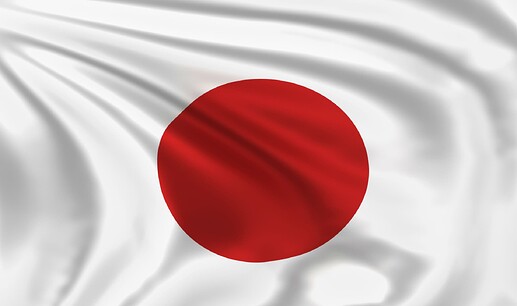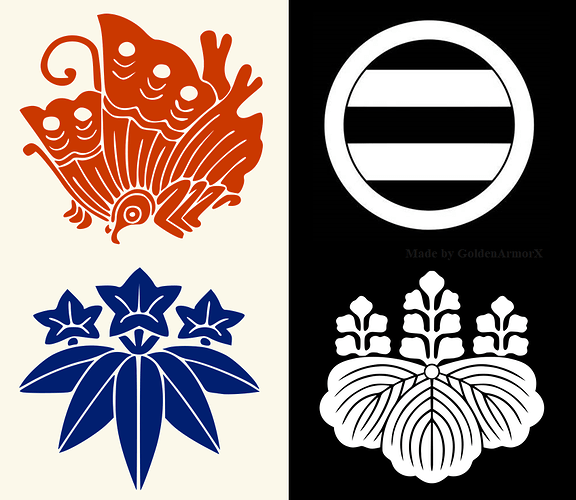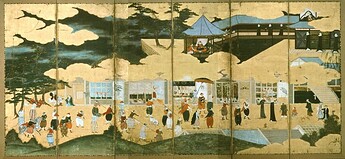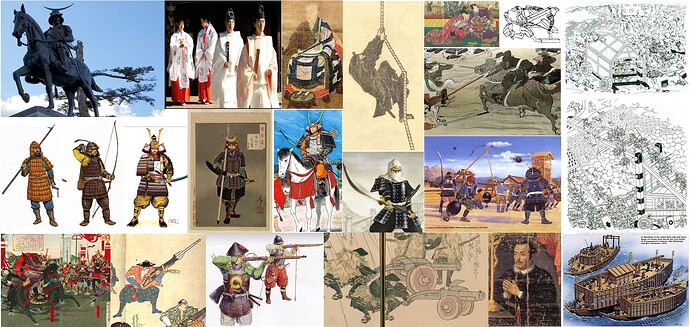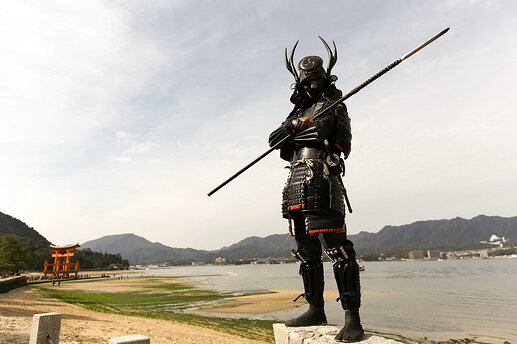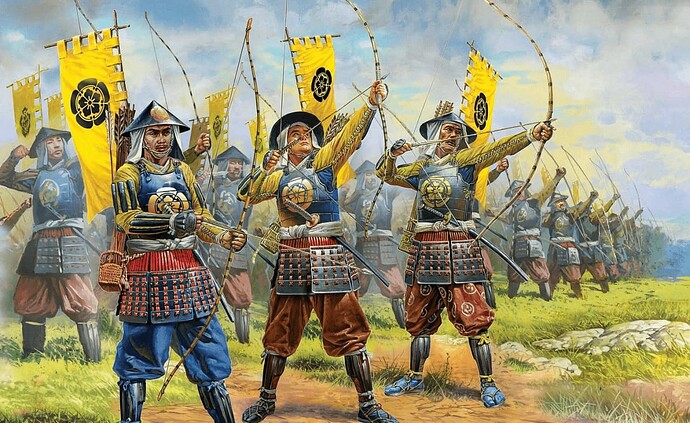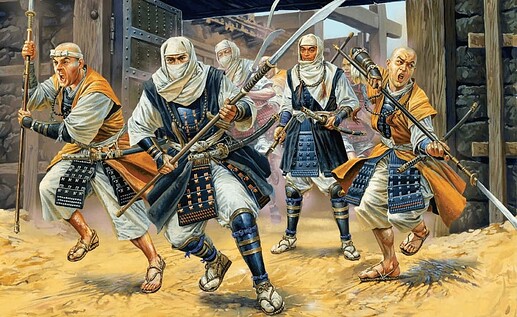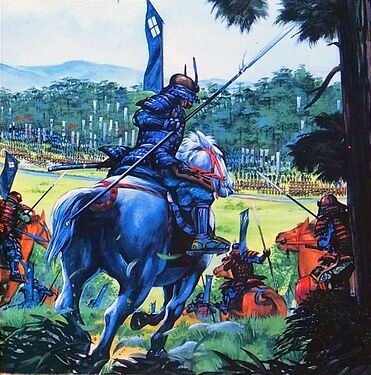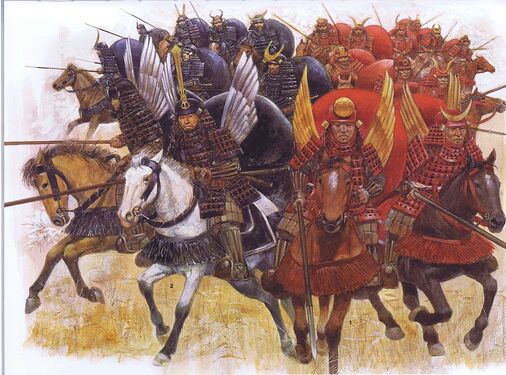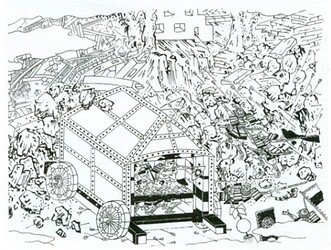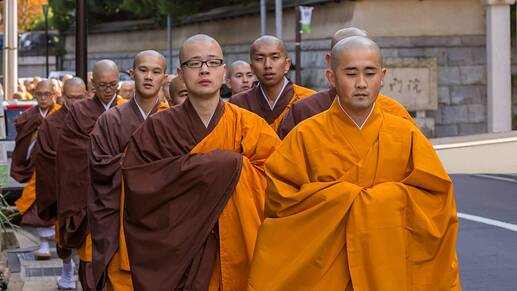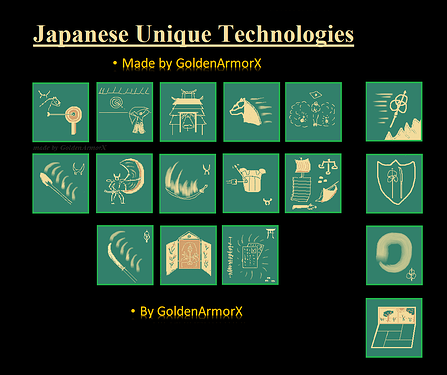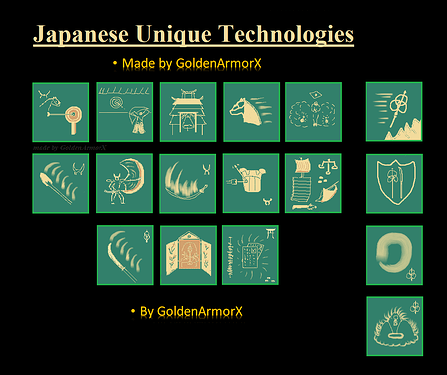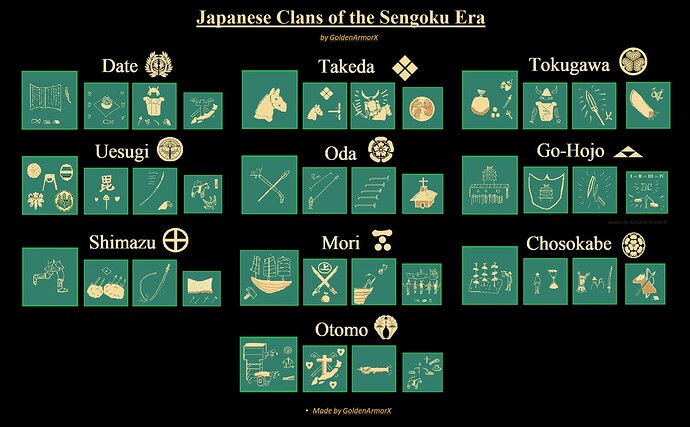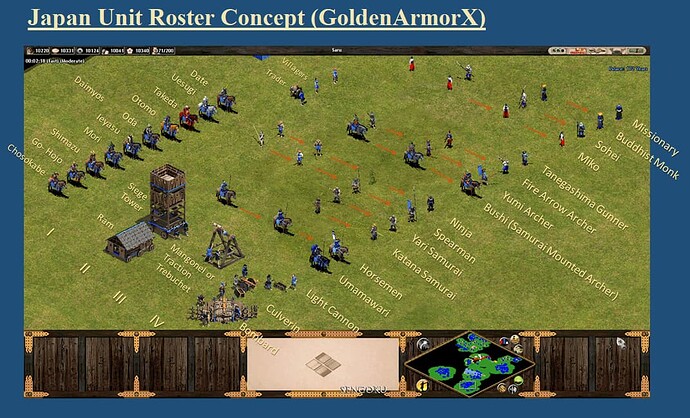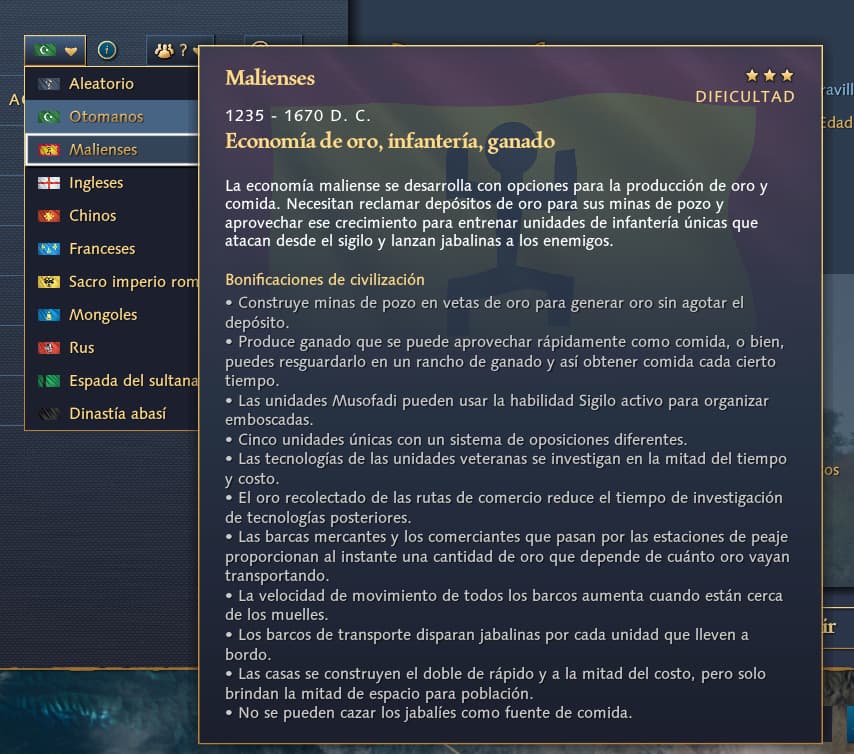JAPANESE CIV. CONCEPT FOR AOE IV
BY GOLDENARMORX - EXTENDED VERSIÓN - PART2
5) Units
“All the Units Collage”
Gameplay.- Japanese have many unit reeplacements. Instead of horseman scout, they have a infantry scout, the Shinobi, who have low HP and less speed but compensate with the hability of “infiltration”, with let them 30 seconds to stealth. They have the regular spearman, archer and horsemen of Dark age and Feudal age, and as a third feudal military unit they have the Bushi (provisional name), a horse archer with heavy armor, and a Lanmark that can produce them 50% faster.
The second Landmark in Feudal Age can let you produce Soheis, infantry anti-cavalry with time limit of life, and acts as a defensive landmark. In third age you can decide beetween two religions, a Landmark with Monks Bonus, or a Landmark with Miko and Sanctuary Bonus, both of them have their counters and pros.
In Castle Age they have the powerful samurai with katana, but lack crossbowmen and Trebuchet, instead they have Bo-hiya bowman and Yumi samurai as a reeplacement. You can either develop the first technology of the clan you pick.
The fourth age lend you build Lancers (Umamawari), ########### Arquebusier (gunpowder infantry) and Nippon Taiyos (cannons). Japanese have acces to a third religious unit in Imperial Age, the misionary, a spanish unit but without the “Santiago” bonus attack, that can convert units without relics. They have either european cannons (bombard and culverin), by the Nanban Trade Center, but cost only Gold with a increased cost. As non-gunpowder siegue units they still have Siege Rams, Siege Tower, Spingard and Catapults.
Units that they lack:- The Japanese lack Crossbow, and Counterweight Trebuchet. His replacement is the samurasis with Yari and Bo-hiya Zutsu.
History: Although there is evidence that the Japanese bought “crossbows from China” and used them in the late Heian period, with the Mongol conquest of China and the Yuan Dynasty’s declared war on Japan in 1270, they could no longer buy them abroad. Regarding the Trebuchet, it was the Mongols who brought the counterweight Trebuchet to China and Korea via Muslim engineers, plus the Japanese, by repelling their 2 invasions thanks to 2 unexpected hurricanes, they never acquired this technology. There are no known records of “crossbowmen” school lore, perhaps because they were not needed, pre-Sengoku period Japanese armor was not strong enough to deflect arrows at 40 meters, so crossbow bolts were not necessary. On the other hand, in the Kamakura and Ashikaga shogunates, Buddhism spread so much in Japan, especially the Blessed Land school, and the doctrine of not eating meat or taking horns and even fur from animals became taboo in society. The most rudimentary crossbows as well as compound bows require tendons, horns or bones to make their torsion mechanisms, or a type of steel not common in medieval Japan. This prevented the weapon from becoming common, save for rare cases of crossbows being imported from China as a “collector’s weapon”. Already by the Sengoku period, with the advent of plate armor based on the European design, the role of anti-armor was fulfilled by two units: the ########### arquebusiers, and the spearmen with anti-armor Yari.
Units List
(I) Dark Age
1.- Villager
2.- Daimyo
3.- Spearman
4.- Shinobi Scout*
(II) Feudal Age
5.- Trader
6.- archer
7.- Archer Samurai*
8.- Horsemen
9.- battering ram
10.- Siege Tower
11.- /Sohei
(III) Castle Age
12.- Monk
13.- ##################### 14.- Samurai with katana*
15.- Samurai with yari*
16.- Lancer
17.- Springald
18.- Mangonel
19.- Bo-Hiya Zutsu*
(IV) Imperial Age
20.- ########### gunner*
21.- Nippon Taiyo*
22.- /Missionary
23.- /Bombard
24.- /Culverin
Ships
1 Fish Boat
2 Transport Ship
3 Trade Ship → Red Seal Ship*(IV)
4 Kobaya (II)
5 Sekibune (II)
5 Atakabune (IV)
6 Tekkousen (IV)*
Military Land Units
Samurai with katana: Japanese heavy infantry, fight with a katana that does moderate damage but at tremendous speed. They have less armor than the man-at-arms, but make up for it with higher movement speed. He possesses an ultra-fast charge attack called “iai” which recharges once they stop attacking for a few seconds. Statistics:
HP: 150/180, Atk 11/13, Def 3/3 4/4, Speed 1.25, Rof: 1.23, Charge atk: 17/20, cost: 100f 25g
- Iai (Ability): Samurais with katana has a charge attack.
- Bullet-Proff Armor (IV): Samurais and Daimyo have 30% resistence to gunpowder attacks.
- Kenjutsu (IV): Samurais with katana attacks 15% faster.
History: The katana wasn’t developed until the 14th century, as a way to imitate and improve the Mongolian sabers recovered from the Mongolian invasions of Japan. Before that, the japanese swords, the tachis, were very fragile and either were more slowest. The Japanese samurai did not use shields. In fact, that’s why it has less armor than the base Men at Arms, not for the actual armor. In sengoku period, the japanese develop the tosei gusoku armor, a plaque armor that are in equal term with european plaque armor, but with a japanese design. A type of technique that can only be done with Katana is the iai, a type of combat where taking the sword out of the scabbard also consists of an attack, which must be lethal and ultra-fast.
Shinobi Scout: Light infantry and scout with long line of reach. He possesses the “Disguise” ability that allows him to enter stealth. He can be upgraded between eras to improve his combat abilities. His feudal upgrade has a bonus against villagers, trade and religious units.
HP: 70/90/110/130, Atk 1/8/10/12, M-Armor:0, R-Armor: 2/3/4, speed 1.60, rof: 1.37, bonus:+10(economics) +10(siege) +10(religious) cost: 70f 10g
- Infiltration (Ability).- Shinobi can use Stealth for 60 seconds if isn´t in combat. Can be detected by outpost or explorers if they are near them.
- Smoke Bomb/Ninjutsu (Ability).- Shinobi enter in Stealth mode for 8 seconds, can be activated in middle of combat, and can be detected by explorer or outpost.
History: Unlike the idealized version of the Edo period, the wars between samurais were not romantic, they were to increase the territory of the daimyo, and for that everything was valid. Publicity mattered, of course, but for that you could always count on mercenaries or irregular soldiers to do the dirty work. Shinobi were irregular soldiers, used for subterfuge, espionage, and reconnaissance missions. Although at first they were just soldiers following orders, over time even espionage became a “military art”, and certain clans specialized in subterfuge and selling their services to the highest bidder. There were many types of shinobi, some sold their services to the highest bidder, such as the Koga and Iga clans. Others served a higher clan, like the Fuma to the Go-Hojo. In any case, they were a real military corps, they could camouflage themselves in enemy territory using civilian disguises, and they were also responsible for several defeats and victories in the sengoku wars.
Yari Samurai: Japanese infantry unique units, armed with a Jumonji-Yari. He is the substitute in “infantry” for the crossbowman. Strong against heavy cavalry and heavy infantry, but weak against crossbowmen and archers in general, fight in equal with horsemen and spearmans. Statistics:
HP: 140/170, Atk 11/13, Def 0/0, speed 1.25, rof: 1.37 (fast), bonus: +12/+15 cost: 90f 30g
- Sojutsu.- Yari samurai attacks 15% faster.
History: During the Ashikaga shogunate, Japanese armies began to develop new battle tactics, including samurai combat on foot. While the sword was the preferred weapon for close range combat, with the development of new, more powerful armor, new weapons were needed that could pierce the new heights of the samurai. During the War period of the Northern and Southern Courts, the kanabo, nodachi, and tomahawk were developed, but they did not become effective enough to replace the katana. Ultimately it was the spear with an anti-armor point that was the most effective and popular weapon for destroying melee armor. The spears used by the samurai were different from the ashigaru, they were shorter for greater maneuverability, and depending on the clan or the backgrounds of the soldier, they could have several points (tridents, jimanji-yari), have a blade of more than 1 m ( tombokiri) and various other modifications. Many famous samurai were masters of the spear, and the weapon became a sign of officers and generals in the Daimyo armies. Toyotomi Hideyoshi’s 7 generals were known as the Seven Spears of Shizugatake. Honda Tadakatsu, Tokugawa Ieyasu’s general, is known for using one of Japan’s 3 legendary spears, with a blade of more than 1 meter.
Samurai archer / Bushi.- heavy armor horse archer of the Feudal Age. He wears some o-yoroi armor and has a fast shooting ratio for ranged cavalry. He can learn the Yabusame skill if it is developed in the gallery.
Stats: 110/125/140, Atk 12/14/15, Def 2/2 → 3/3 → 4/4, Speed 1.53, rof: 1.63, range: 4.5, prod: 33s, ct: 100f 60g
- Yabusame (III): For 6 seconds, the archer samurai can fire 3 shots with a rof of 0.83. C:60 seg
History: At the end of the Heian period, a civil war broke out between 3 noble clans, the Minamoto, the Fujiwara and the Taira to seize control of the country and wrest it from the Emperor. During this war many of the noble soldiers used archer cavalry, one of the most prominent being Minamoto no ######### who is presumed to have destroyed a ship with a single arrow. Although this story is legendary, the truth is that these armies of archers on horseback were decisive in the creation of the first Shogunate, that of Kamakura, which brought the Minamoto to power. Since then, archery on horseback would be the distinctive combat symbol of the noble warriors, or bushi, who would only fight on foot when they ran out of arrows or were cornered. Over time, to further improve the ability of archers on horseback, several sports were created, one of them Yabusame, which consists of shooting at static targets on horseback in a short distance, is still standing today. The use of archery on horseback declined in the Sengoku Era, eclipsed by the appearance of new combat techniques, such as cavalry charges, noble infantry formations on foot, and the advent of firearms, which many samurai used. they were reluctant to adapt, preferring that ashigarus (peasants or mercenaries) be the ones to use these weapons.
Archer.- ranged infantry with a powerful yumi bow. Since it is not compound, it can be big but is damage is normal, but it become compound with the pass of ages (hitogumi).
HP: 70/80/95, Atk 5/7/8, Def 0/0, Speed 1.38, rof: 1.5, range: 5
-Kyodo: Archer attacks 15% faster.
History: The Japanese bow is different from other bows, it is asymmetrical, and is made of several sheets of bamboo instead of a single tree. This very interesting structure has the function of improving its use in archery on Horseback, a fighting method that the Japanese nobles used. However, being mass-produced, and in order not to waste overproduction, non-noble foot soldiers, even warrior monks, also used this asymmetrical bow. The art of bow fighting “to the kill” is Kyojutsu, which describes any school that teaches how to use the bow for military purposes. Over the centuries, the bow managed to become “composite” improving its effectiveness and ############ being useful to fight even during Sengoku wars, being an alternative to the ########### arquebus, having a much higher rate of fire and lethality than 40 meters away even with heavy armor.
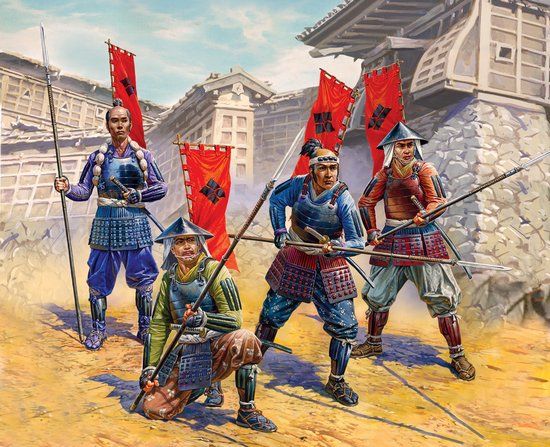
Spearman.- The classic spearman, but in a Japanese version. Aesthetically he would use a Hoko, an ancient spear, for feudal a Naginata, and for the elderly a simple Yari on a bamboo stick, for imperial a Nagae-Yari, the closest thing to a pike in Sengoku Japan. Same stats as normal spearman:
History: The spear is the most common weapon in ancient history, perhaps because it consists of a stick with something else attached to it. In any case, the Japanese have employed soldiers with spears since immemorial times, only the description for this was Hoko. By Heian times, the most common polearm was the Naginata, of which there were several types and was more similar to a Glaive than a weapon made for dismounting cavalry. Mass formations of spearmen to destroy cavalry were not carried out until the 14th century, where after a battle where an army armed with bamboo spears defeated an army 3 times larger, the rest of the clans tried to invest in this new type of tactic. The spears then became a weapon to improve, creating new types and shapes, appearing the term Yari to refer to them, and creating sub-variations of it, in the form of a Trident (Jumonji-Yari), of Pica (Nagae-Yari) or sickle (Kama-Yari). In general, the ashigaru, or non-noble troops, used long spears like pikes, to make them stand out as a group, while the samurai who used spears preferred short spears or ones with more useful designs in personal combat, mainly to prove their abilities and get battle achievements. For that purpose, normally ashigarus usaban spear
Sohei.- Swift warrior monk who fights using a naginata with an elongated blade. He is also considered light infantry and religious units. He has a bonus against cavalry. Weakness: skyshy. Statistics:
HP: 85/120/150, Atk: 8/11/14, Def 1/0, Speed 1.5, Rof: 1.37 Bonus:+10/13/16 (Cav), cost 80a 10g, or 20w (Landmark), train:35s
History: During the Heian period, Japan encountered the migration of various Chinese Buddhism teachers who began to proselytize their schools with the authorization of the Japanese Emperor. Many of these schools had a particular vision of Buddhism, some of which taught that even if one wanted to achieve enlightenment, earthly affairs ultimately led one to do things sometimes considered taboo. Thus, some schools, to avoid what they considered heretical doctrines, or just to recruit more adherents, declared war on the rest. It was the beginning of a religious war. Warrior monks armed with various types of weapons, of which the Naginata was the most common, took up arms against each other. Already during the Gempei wars (1180-1185) several schools of Buddhist monks allied with both the Taira and the Minamoto sides. Many temples were burned but in the end the Buddhist monks who helped the clan that won the conflict were held in high esteem, and Buddhism began to proselytize more now with the support of the new Military Government. Warrior monks would continue to be involved in more conflicts, even during the Sengoku era, where the Ikko-Ikki, peasants tired of feudal domination rose up in arms allied by warrior monks to declare their land as their own.
############# ashigarus tumblr_ncf7fav3fe1tg8jkro2_1280|690x423, 75%](upload://AmzMWk3MpCkIS7vGDm1tNfD7leF.jpeg)
############### arquebusieur.-**** Japanese gunpowder unit, although it uses a arquebusier, due to technical limitations it does the damage of a normal handcannonner. He can create a mini bamboo stockade that stuns cavalry briefly.
HP: 130, Atk 35, Def 0/0, Speed 1.25, rof: 2.13, range: 4, cost: 120g 120g
- Taketaba(竹束): allows you to create an orderly bamboo palisade in front of the arquebusier that stuns the cavalry attacking from the front for 2 seconds. C: 30sec
History: In the year 1543, a group of Portuguese ventured to Japan and ran aground in Kyushu. There they sold 2 arquebuses to a feudal lord, ########### Tokitaka. In less than a year, and through reverse engineering, the Tokitaka blacksmith managed to create his own version of the Japanese arquebus, but he couldn’t activate it no matter how hard he tried. When the Portuguese returned a year later, they solved the problem with Portuguese blacksmiths. The new firearm was named after the clan leader who discovered it, and would see use on almost every battlefield of the Sengoku era. The weapon was viewed with suspicion by various Japanese clans, who still preferred to use the bow as a ranged weapon, however it was Oda ######## who would prove its deadly effectiveness, almost completely decimating the Takeda clan, one of the most powerful clans in Japan in a single decisive battle, where he used bamboo palisades to prevent cavalry charges while a volley of fire decimated Takeda’s troops from the other side. This iconic weapon continued to be used until the end of the Sengoku period, when the Tokugawa took over the entire island, and there were no more wars to be fought… except maybe 10 or 20 revolts until the Meiji era, but hey that’s another story.
Horsemen.- Japanese light cavalry, wears a naginata (II), but later changes it to a Yari (III-IV). Same stats as normal horsemen.
History: During early medieval Japan, cavalry took a somewhat different course than the rest of the world. Cavalry was expensive, only well-financed noble soldiers could afford a horse. The preferred form of fighting on horseback was “archery on horseback”. It was unknown or unknown what “cavalry charges” were. The horses weren’t ######### for war (I didn’t even know this) so they were violent and required more training. Still, cavalry in Japan was also developed for hand-to-hand fighting. In the Genpei wars, warrior monks who could rear horses also fought mounted using naginatas. Latter, during the Onin wars, melee cavalry began to prove its effectiveness in taking down archers and disorganized infantry formations. Already by the Sengoku era, both by innovation and by foreign influence, many clans in flat lands began to use the tactics of Cavalry Charges, the most prominent clan in this was the Takeda clan.
Umamawari.- Heavy cavalry army with a yari to cavalry charges and a Nodachi in close combat. Japanese version of the lancer and knight. It represents the Umamawari, a heavy cavalry of the daimyo royal guard. it’s probably called as “Lancer”. Same stats, but only unlocked historically in IV age (or III if for balance issues). Stetically has a Horo in its back and a kabuto general helmet.
History: The Umamawari was established in the Sengoku Period (Period of Warring States) (Japan) and was a job based on the government service system for samurai families. Horse guards were mounted samurai retainers who accompanied commanders’ horses as their bodyguards and served as messengers or soldiers in wars. They also served as bodyguards for feudal lords (daimyo in Japanese) and performed administrative duties as their aides or deputies. One of the most frequent symbols of these royal guards was the Horo, a cloak placed on a support behind the saddle, which gave a sign of status and imposition to this special cavalry. At least in Honshu, in the plains area, every self-respecting clan had a mounted guard, from the Oda clan with its famous “red guards” and “black guards”, as well as Toyotomi Hidetoshi, who added to the previous one the " golden guard".
Daimyo.- Cavalry Unique Unit*. Represent the Daimyo. Appears as a new unit in your Home Center if you choose one of the available clans and are in available since III age. If you dont choose a clan until 4th age, you get one either in forth age. His appareance deppend of the clan you choose (if you are loyal to the Soghun and the Emperor in fourth age you get a Hideyoshi Daimyo). Has abilities to improve your soldiers:
HP: 300/450, Atk 16/32, Def 4/4 5/5, Speed 1.62, Rof: 1.25, Cost: Free 45sec
- Daimyo loyalty: Increases the attack of nearby melee units within 5 tiles by 15% by 10 seg. C:60seg
- Honjin Sonae: Create a Campment where units whitin 5 tiles that don´t combat heals 2p/seg. C:60seg
History: Originally called Shugo in the Katakura period, they were in charge of replacing the Kokushi, public officials at the service of the emperor in charge of administering the mansions, or fiefs. Of course, unlike the Kokushi, the Shugo’s job also included “eliminating” threats that endangered the fiefs, such as bandits or mercenary armies, even neighboring armies. While the system worked initially, during the Ashikaga period, political power became so decentralized that many regions became self-sufficient domains, independent of the politics of the capital. The shugo with the largest territory began to call themselves “shugo-daimyo”, later, they were only called Daimyo, and to invade their neighbors to expand their territories. After the Oni Wars (1480), the Ashikaga shogunate was so weakened that it could no longer control any province that was not adjacent to the capital, the Daimyo were free from ties and they could declare war openly throughout Japan, beginning the period known like Sengoku Jidai. Each Daimyo had armies with troops from their main clan, subordinate clans, allies, and mercenaries, if they had the money to pay for them. For more than 100 years they fought each other trying to increase their land, although few tried to take over all of Japan. There were only 3 who managed to conquer almost the entire coastline, known as the 3 unifiers: Oda ######### Toyotomi Hideyoshi and Tokugawa Ieyasu.
Siege units:
Rams.- Known as Kurumakari or Kurumakakari. Same stats as the classic battering ram.
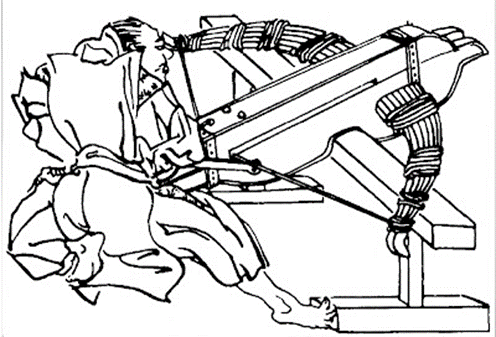
Springalds.- Although there are no machines called springalds, it is known that the Japanese used “Oyumis”, a type of Ballista, both defensively and for sieges, during the 11th and 12th centuries, especially during the Gempei Wars. Although there are no drawings or plans of the weapon, there are many writings that refer to its use. The period of peace resulting from the First Shogunate may be the cause of its decline. The fact that they were made of wood also contributed to their rot. The use of Chinese Mangonels (Hoseki) as siege anti-units can also be the cause of their replacement.
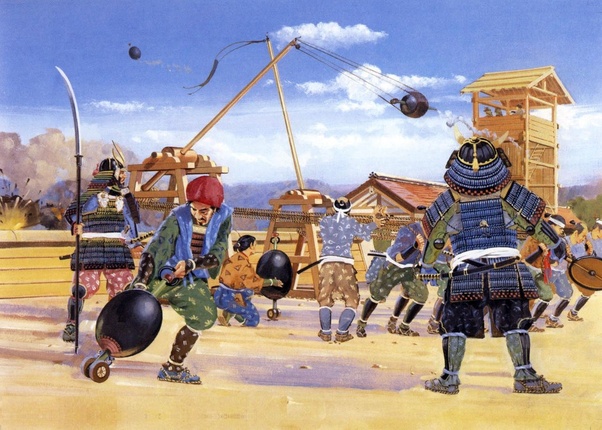
Hōseki.- A type of catapult. The Japanese describe that during the North and South Court Wars and the Gempei Wars, they employed siege weapons that hurled “huge stones”, primarily as “anti-unit” weapons. Whether they were onagers, catapults or traction trebushet, there are no plans to define it. It is generally believed that they could have been Chinese mangonels (Sijiai), of which the Japanese already had plans, only as a personal innovation they added explosive grenades instead of stone as ammunition. Personally I would give them the same stats as the mangonel or similar, I would just change the design to the Chinese model, and maybe an explosive area damage effect.
I repeat that the Japanese lack Counterweight trebushet. While they could give it the Mongolian unique unit, Traction Trebushet, technically all Mangonels in the game are “Traction Trebushet”, but since the onager skin is a classic, they gave that skin to all civs (HRE, english, french , abbasid, etc.). That being the case, we better give way to the next unit that would replace the trebushet.
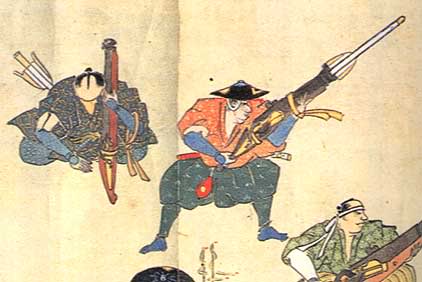
Bo-Hiya.- Or arrow of Fire, is a unit of III age, infantry of rank and siege. Aesthetically, he is an archer with a yumi bow and a Fire Arrow (Bo-Hiya), in IV age he evolves into a Rifleman with Ozutsu and the arrow used as a bullet. It has ranged damage, low anti-unit accuracy, with anti-building and anti-ship bonuses and a range of 12. It takes extra damage from both anti-siege and anti-ranged units, making it easy to kill.
HP: 90/105, Atk: 13/16, Def: 0/0, Speed: 1.10, Rof: 4.25, Range: 2-12, Bonus: +30/40 (Building), +24/+30 (Boats) , +10 (Reap), cost: 75w 100g
History: The bo-hiya or Bōbiya was a type of fire arrow, not a flaming arrow, but an arrow attached to a rocket or infused with an explosive substance so that it reaches a greater distance when crashing, or ignites the place crash. Possibly based on Chinese fire arrows, it was initially used by the Japanese using Yumi bows, especially by the Japanese Wako pirates, who on more than one occasion tested it against Chinese and Korean ports. With the development of firearms in Japan, the Ozutsu was invented, a type of high-powered rifle, which was capable of using a Bo-hiya as a bullet, creating the term Bo-hiya O-zutsu. Using both weapons, the fire arrow could reach astonishing distances. According to Micifumi Isida, in the document “Dokuyaku no kata”, it was calculated that it can reach up to 3 km away. This weapon was used during Sengoku wars, especially in sieges, to burn structures or ships in sea battles.
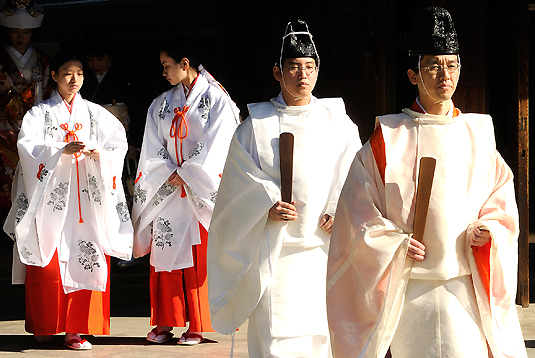
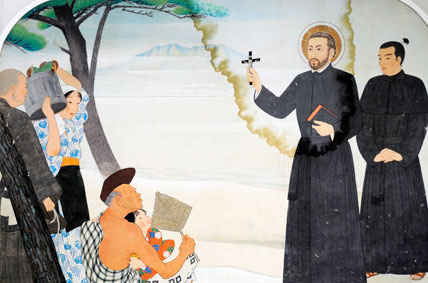
SHIPS
- Fishing Boat - The classic fishing Boat.
- Trade Ship.- The classic Trade Ship, but can improve to Red Seal Ship* by Unique Tech.
- Transport Ship.- The classic Transport Ship.
- Archer Ship.- Kobaya (II)
- Springald Ship.- Sekkibune (II)
- Incendiary Ship.- Fire Kobaya (II)
- Warship.- Atakabune (IV)
- Special Ship (IV).- Tekkebune.
Tekkebune.- Unique Japanese ship of the Imperial Age. It is a stronger version of the Warship, but more expensive as well. She is covered with steel around the edges, which gives her extremely high missile defense, as well as being one of the few ships with fire defense.
Stats: HP:700, Dmg: 45 reap, Bonus:+210 vs Buildings, Arm: 0/5, Rof: 5.63(x3), Range: 9, Spd:1.25
Red Seal Ship.- Unique Japanese ship of the Imperial Age. She is a version of the merchant ship but with skill. She comes to him by developing a technology that converts all merchant ships.
Normal: Stats: HP:250, Dmg: none ------ (x0), Arm: 0/0, Rof: none (x0), Range: 0, Spd:1.5
RDS__: Stats: HP:250, Dmg: 15 siegue (x3), Arm: 0/0, Rof: 5.63 (x1), Range: 8, Spd: 1.8
History.- During the Japanese medieval period, maritime warfare went through several stages. During the Heian period, the Japanese were a ###### state of the Chinese empire. During this time several diplomatic missions were sent to China to pay tribute to their emperor. Thus also the battles were limited to boarding and the shooting of incendiary arrows. At the end of the Heian period, during the Gempei wars, Japan experienced several combats at sea, where several oyumis or Ballistas were used. A 100-year period of peace in the Kamakura shogunate would cause the Japanese naval forces to relax too much, to the point that when the Mongols arrived in 1280, the majority of the Japanese navy was made up of armed fishing and trading ships. It would not be until the Oni wars in 1470 where new types of ships would begin to be used. These would first be divided into 3 categories, Light or Kobaya, Medium or Sekibune, and Heavy or Atakabune. The Oda clan specially created a new model of ship, called the Tekkousen, which was an Atakabune covered with steel sheets. This new type of ship would be used in the invasion of Korea by Toyotomi Hideyoshi and distributed among several clans. Likewise, during Hideyoshi’s government, a new type of ship authorized for trade was created, the Red Seal Ship, which would later include Foreign elements in its construction, such as the use of lateen sails, or the presence of side cannon batteries such as self-defense measure.
More info about technologies and Clans system in Part3 →
